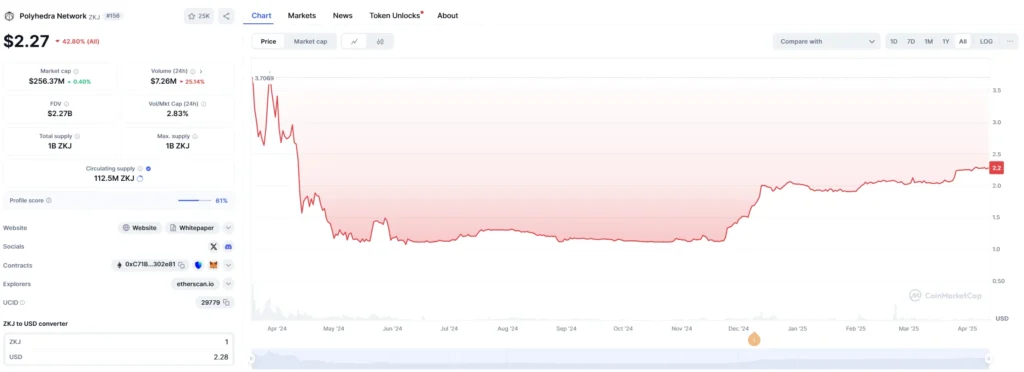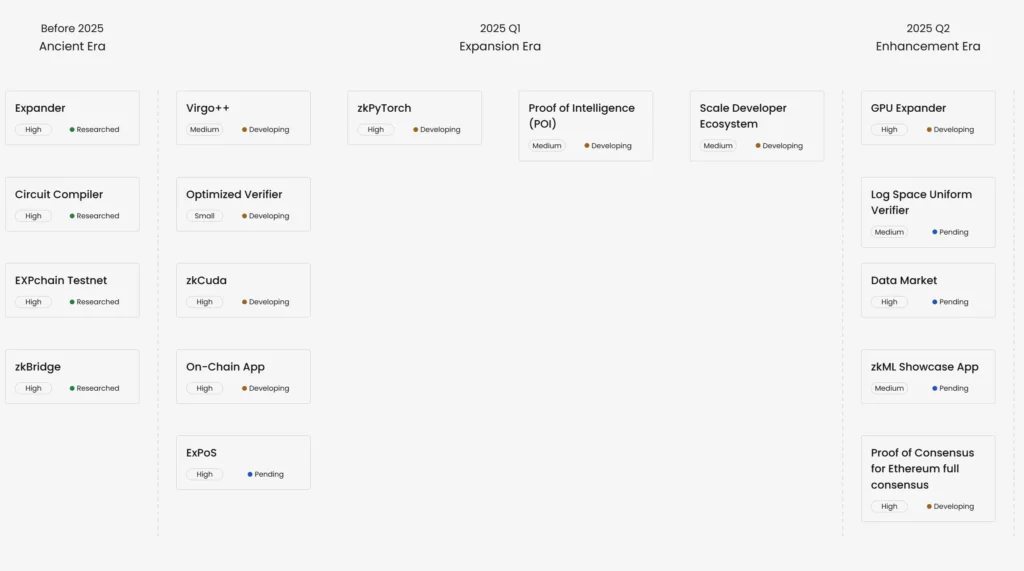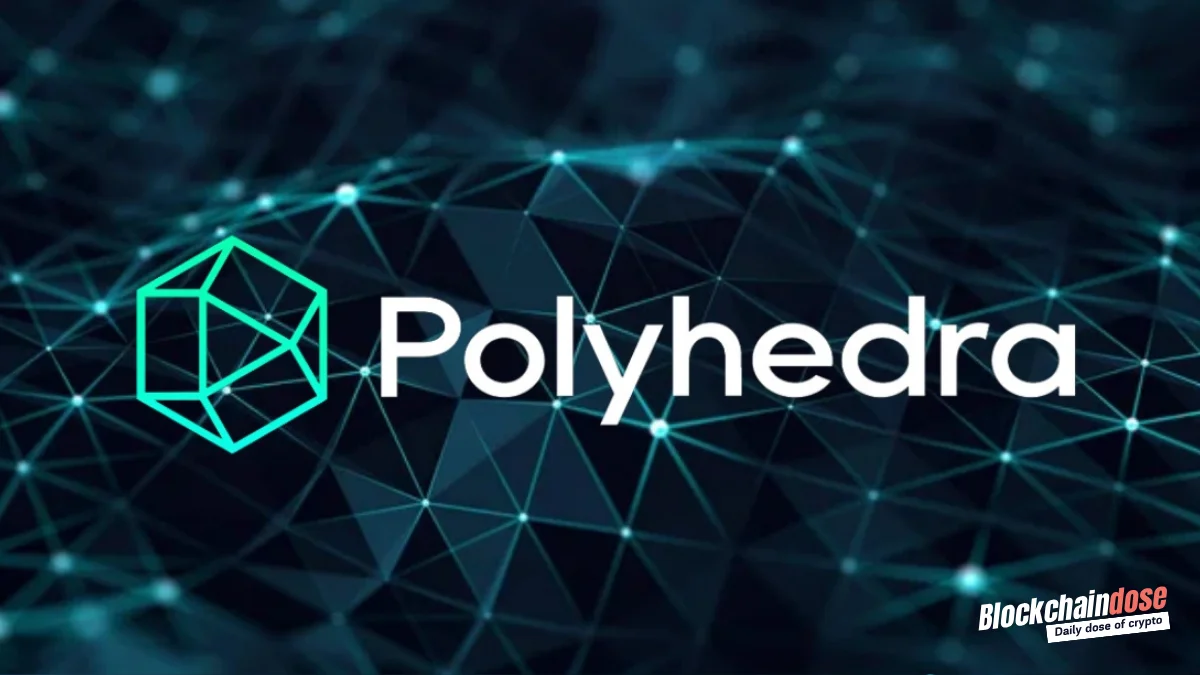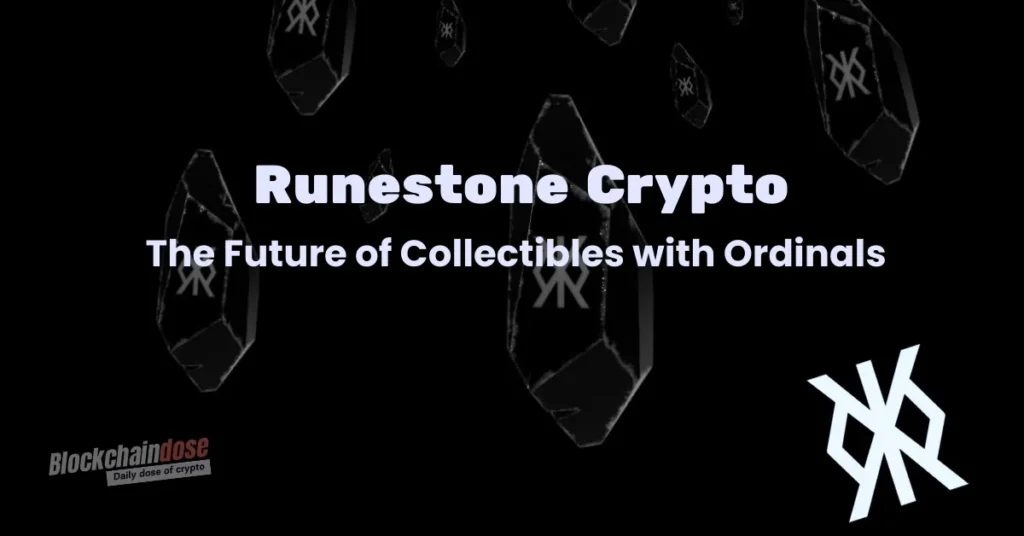Scalability, interoperability, privacy – those are the three most primary challenges affecting blockchain technology this far. But what if I told you that there is already a solution for all these challenges? Enter Polyhedra Network— The ZKP powered tool fostering blockchain interoperability.
Key Takeaways
- Understand that Polyhedra Network is a platform designed to lay foundations with next gen infrastructure for blockchain growth.
- The Polyhedra network functions by combining key tools like zkBridge, zkDID and Distributed Proof Generation Network.
- In the Polyhedra network there is a token named $ZKJ which has immense potential.
- The roadmap for Polyhedra looks promising, and the team behind this project is quite reliable.
What is The Polyhedra Network?
Launched in 2023, Polyhedra emerged as a crypto network built to lay the groundwork for the future of blockchain. Its mission? To bring futuristic infrastructure that fosters proper Web3 interoperability, scalability, and security. Polyhedra has one simple long-term goal: to be the home for the best cross-chain solutions for all L1s and L2s.
Acting as a powerful bridge for blockchain networks, Polyhedra already supports over 20 L1 and L2 networks, including Ethereum, Arbitrum, BNB Chain, and others.
The ZKP protocols hosted by the Polyhedra network enable communication across blockchain networks. This improves important areas like interoperability, privacy, and communication between chains.
As of 2025, Polyhedra has already built several next-get zkSNARK protocols like zkBridge, zkDID, and ParaPlonk.
How Does Polyhedra Network Work?
What really sets Polyhedra apart is its innovative implementation of Zero-Knowledge proofs, especially with zkBridge and zkDID. In fact, the founding technology behind the Polyhedra network is advanced ZKP technology. Zero-knowledge proofs, or ZKP as it is acronymed, essentially allow party one to prove the knowledge of some information without revealing the actual data.
By leveraging ZKP technology, Polyhedra achieves proper functionality. However, the ecosystem’s functionality is as follows:
zkBridge
The zkBridge is designed to address the challenges of interoperability between blockchain networks. It provides a trustless pathway for blockchains to communicate, exchange information, and transact. Traditional cross-chain solutions work with assumptions, leaving them vulnerable to threats.
In zkBridge, however, the narrative is completely flipped. Imagine using ZKPs to verify consensus between chains in a trustless manner. Owing to its implementation of ZKP, zkBridger powers a wide range of apps, facilitating the transfer of assets, messages, and even data across various blockchain networks.
Distributed Proof Generation Network
This is a network designed with several technologies, including deVirgo and paraPlonk, all designed to accelerate the generation of proofs while reducing the costs associated with on-chain verification.
With deVirgo, Polyhedra can enjoy optimal parallelism and minimal communication overhead. As such, zkBridge functions 100x faster than traditional systems. Paraplonk, on the other hand, bolsters the scalability by providing large-scale distribution. In other words, paraPlonk opens the way for decentralized zkRollup and zkEVM solutions.
zkDID
zkDID is Polyhedra’s answer to decentralized identity. This tool functions strictly according to the principles of verifiable credentials and soul-bound tokens. The end game for this tool is onboarding over a billion internet users to the world of Web3. The zkDID platform helps users maintain control of personal information.
For instance, the network has a stealth address mechanism powered by zero knowledge proofs. This network supports millions of verifiable credentials every second and strictly adheres to W3C standards.
Polyhedra Token: $ZKJ
With a massive commitment to building a trusted experience for the intelligent future, Polyhedra brings its new token, $ZKJ. This new token will play various roles within this ecosystem.
This token will be used for:
- EXPchain gas fees — Developers, Dapps and stakeholders can pay fees to enjoy a good experience with projects on EXPchain. They pay the fees with $ZKJ.
- Zero-knowledge proof service fees—Since Polyhedra offers ZK-proof services, $ZKJ can be used to pay for them.
- zkBridge transaction fees — ZKJ can also play a big role in helping decentralized apps pay cross-chain transaction fees for zkBridge.
- Staking — Network stakeholders can hold ZKJ and participate in verifying transactions, effectively earning rewards. In general, the ZK provers will stake their tokens and participate in the ZKP network, receiving rewards as the result.
- Economic security—The $ZKJ token will be used alongside EigenLayer restacking to provide crypto-economic security. The dual staking mechanism will be used to secure the trust-minimized bridge from Ethereum to Bitcoin.
- Governance — $ZKJ token holders can vote on Polyhedra Network governance on its infrastructure and ecosystem decisions.
The ZKJ token launched on the Ethereum and BNB Chain, taking the ERC-20 and BEP 20 formats, respectively.

The Tokenomics of Polyhedra Token
The Polyhedra network sets the maximum token supply at 1 billion. The initial circulating supply, as per data, stands at 91 million, which is 9.1% of the total max supply.
How is Polyhedra allocating the tokens? It is as follows:
- 15% of the total token supply is issued to the community, airdrops and other community-focused activities. By the end, about 150 million tokens will be issued in this form.
- 32% (320 million) of the tokens will be issued in the form of incentives for participating within the network and ecosystem
- 15% (150 million) of the tokens are foundation reserves.
- 28% (280 million) of the tokens sold to token purchases.
- 10% (100 million) issued to the primary contributors.
Polyhedra Token (ZKJ) Price According to Coinmarketcap
What is more interesting about ZKJ is its price action since its birth. As per Coinmarketcap charts, ZKJ was listed on Coinmarketcap just about one year before this report was written. During the listing date, ZKJ was trading at just about $3.7069.
By June 2024, ZKJ was trading at a very low price of just about $1.07. This trend continued for a few months until about November of the same year.
ZKJ began its comeback story in late November or early December, rising first to the $2.06 mark. This token later surged to hit the current 11-month high of $2.2.
At its peak, the Polyhedra market cap was just about $680.7 million, with volumes at $13.56 million. When writing this report, in late March 2025, ZKJ’s market cap was actually a little over a quarter of a billion.
Polyhedra: The Roadmap
On their Web page, Polyhedra has outlined their roadmap, specifically highlighting what they have already done and what they will do in the future. The Polyhedra team has already researched the Expander, Circuit Compiler, EXPchain Testnet, and zkBridge.

Polyhedra calls 2025 the expansion era. Many more projects are under development, including Virgo+++, zkCuda, Optimized Verifiers, Onchain App, EXPoS, zkPyTorch, Proof of Intelligence, and Scale Developer Ecosystem.
Polyhedra: The team behind the project
The Polyhedra network has a strong team of experts working in unison to provide the best network. Among the best team members include:
- Abner Jia—As the Co-founder and CEO of Polyhedra, Abner is one of the foundations of the Polyhedra network.
- Tiancheng Xie — Another Co-founder, Xie, is the current CTO of the entire Polyhedra network and ecosystem.
- James Zhang is another network co-founder who plays a role in its operation.
- Eric Vreeland — He is the chief strategy officer of the Polyhedra network.
In addition to the above, the Polyhedra team is made up of top developers, researchers, and engineers from top institutions like Stanford University, UC Berkeley, and Tsinghua University.
Polyhedra Social Networks and Numbers
Discord: https://discord.com/invite/polyhedra-network — Over 458 thousand members
X: https://x.com/PolyhedraZK — Over a million followers
Telegram: https://t.me/PolyhedraGroup — Over 31 thousand community members.
Conclusion: Polyhedra Network
The Polyhedra network thrives with its wide range of ZKP products designed to improve the blockchain ecosystem’s scalability, interoperability, privacy and efficiency. Already bringing efficient solutions to many L1s and L2s, Polyhedra is becoming a go-to platform for many developers.
In general, Polyhedra is not merely another player in the world of Web3; it is building the foundation for the next wave of decentralized infrastructure. Developers, investors, and enthusiasts can all explore the Polyhedra network, from the zBridge, zkDID, and even $ZKJ.
Backed by a visionary team and an ambitious roadmap, Polyhedra is clearly not just dreaming big—it’s building boldly. As the expansion era unfolds, all eyes will be on what this innovative project accomplishes next.
Frequently Asked Questions About Polyhedra Network
zkBridge is a Polyhedra made tool using ZK proof constructions to convince receivers that some transition happened. This provides an efficient and trustless cross-chain infrastructure for L1 and L2 interoperability.
You can buy the $ZKJ token through a step which includes setting up your trust wallet, buying ETH, selecting a DEX to work with, connecting your crypto wallet and trading the ETH with $ZKJ. You must do thorough research on the wallet, and exchange you will be using.
How does zkBridge work? This platform leverages zk-proofs, known popularly as zk-SNARKs to send and verify block headers, and even reach consensus in different blockchains. In general, by employing zk-proofs, the bridge creation is achieved without compromising security.




